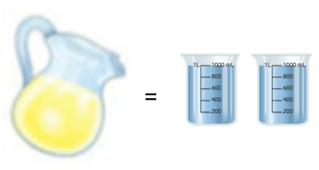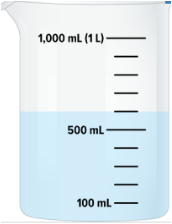Metric Capacity
1 L = 1,000 mL
Capacity is the amount of liquid a container can hold. Another phrase for capacity is liquid volume.
In the metric measurement system, the basic unit to measure liquid volume is the liter (L).
A milliliter is a much smaller metric unit of capacity. It takes about 20 drops in an eyedropper to equal 1 milliliter. There are 1,000 milliliters in 1 liter. The prefix milli- means 1,000.
Metric Capacity
1 L = 1,000 mL
Example 1
Maria made a pitcher of lemonade.
The capacity of 1 pitcher is shown by the amount of lemonade in the 2 beakers. What is the total capacity of the pitcher in liters?

There are two beakers. Find the amount of lemonade in each beaker. Then find the sum.
To find how much is in each beaker, identify the line at which the lemonade has filled the beaker.
For the first beaker, the lemonade reaches 1000 mL, which is equal to 1 L. The same is true for the second beaker.
Find the sum.
1 liter + 1 liter = 2 liters
The pitcher holds 2 liters of lemonade.
Example 2
Andretta is using vinegar for a science experiment. The picture shows the amount of vinegar that Andretta has.

What is the liquid volume of the vinegar in Andretta’s beaker?
Each line marked on the beaker represents 100 milliliters.
Starting from the bottom of the beaker, count by hundreds until you reach the line where the liquid stops at 600 milliliters.
There are 600 milliliters of vinegar in Andretta’s beaker.
